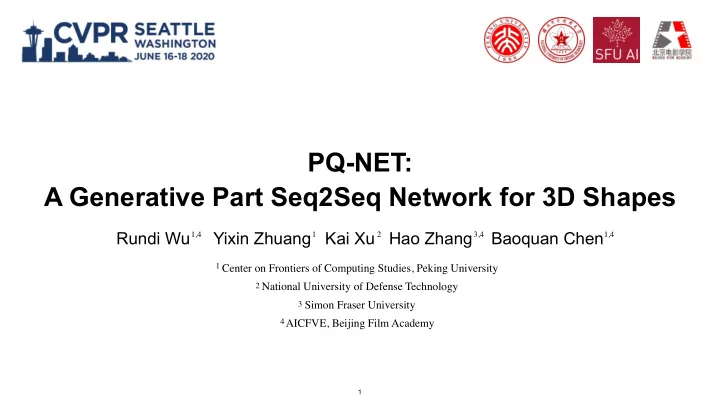

PQ-NET: A Generative Part Seq2Seq Network for 3D Shapes Rundi Wu Yixin Zhuang Kai Xu Hao Zhang Baoquan Chen 1,4 1 2 3,4 1,4 1 Center on Frontiers of Computing Studies, Peking University National University of Defense Technology 2 Simon Fraser University 3 4 AICFVE, Beijing Film Academy 1
3D shape generation Voxel grid Point cloud [3DGAN, NIPS 2016] [Pointflow, ICCV 2019] Implicit function Mesh [AtlasNet, CVPR 2018] [DeepSDF, CVPR 2019] 1. J. Wu, C. Zhang, T. Xue, B. Freeman, and J. Tenenbaum. Learning a probabilistic latent space of object shapes via 3d generative-adversarial modeling. In Advances in Neural In- formation Processing Systems , pages 82–90, 2016. 2. G. Yang, X. Huang, Z. Hao, M.-Y. Liu, S. Belongie, and B. Hariharan. Pointflow: 3d point cloud generation with con- tinuous normalizing flows. 2019 IEEE International Conference on Computer Vision (ICCV) . 3. T. Groueix, M. Fisher, V. G. Kim, B. C. Russell, and M. Aubry. A papier-maˆche ́ approach to learning 3d surface generation. In Proc. CVPR , pages 216–224, 2018. 4. J.J.Park,P.Florence,J.Straub,R.Newcombe,andS.Love- grove. DeepSDF: Learning continuous signed distance func- tions for shape representation. In CVPR , 2019. 2
Structural 3D shape generation [GRASS, SIG 2017] 1 2 4 [StructureNet, SIGA 2019] [3D-PRNN, ICCV 2017] 3 [G2L, SIGA 2018] 1. J. Li, K. Xu, S. Chaudhuri, E. Yumer, H. Zhang, and L. Guibas. Grass: Generative recursive autoencoders for shape structures. ACM Trans. on Graph. (SIGGRAPH) , 2017. 2. C. Zou, E. Yumer, J. Yang, D. Ceylan, and D. Hoiem. 3D- PRNN: Generating shape primitives with recurrent neural networks. 2017 IEEE International Conference on Computer Vision (ICCV) , Oct 2017. 3. H. Wang, N. Schor, R. Hu, H. Huang, D. Cohen-Or, and H. Huang. Global-to-local generative model for 3d shapes. ACM Transactions on Graphics (Proc. SIGGRAPH ASIA) , 37(6):214:1214:10, 2018. 4. K. Mo, P. Guerrero, L. Yi, H. Su, P. Wonka, N. Mitra, and L. J. Guibas. Structurenet: Hierarchical graph networks for 3d shape generation. ACM Trans. on Graph. (SIGGRAPH Asia) , 2019. 3
Shape structure presentations � hierarchical part organization phrases nested in phrases ≈ � linear part order linear string of words ≈ “ ” 4
Generate as a sequence • Our network, PQ-NET, learns 3D shape representation via sequential part assembly Input Sequential Generation Random Z Noise RGB Image Depth Map Partial Shape 5
Method a. Apply IM-NET to encode each scaled part’s geometry b. Model sequential part assembly using a Sequence-to-Sequence Auto-encoder (Seq2Seq AE) a) Part Geometry Encoding b) Sequential Part Assembly and Generation Initial Inverse GRU GRU GRU vector Order GRU GRU GRU h z GRU GRU GRU D ( x, y, z ) E E E E D D D Apply transformation CNN encoder E Implicit decoder D Number of parts (one hot) Stop Sign Part Box Parameter Part Geometry Feature 6
Method - Part geometry encoding Similar architecture as IM-NET : 1 • a CNN encoder maps 64^3 voxelized part to 128D vector e P • a MLP decoder that predicts the occupancy of a given point p d D ( x, y, z ) E A set of sampled ground truth points from P signed function CNN encoder E Implicit decoder D 1. Z. Chen and H. Zhang. Learning implicit fields for generative shape modeling. Proceedings of IEEE Conference on Computer Vision and Pattern Recognition (CVPR) , 2019. 7
Method - Seq2Seq AE Encoder : • a bidirectional stacked RNN to encode part sequence Part k Part k-1 Part 1 Stacked GRU Cell Inverse h r h r h r Number of parts in one-hot representation Order 0 1 2 Part Box Parameter : 6D, position + size h 0 h 1 h 2 Part Geometry Feature : latent vector encoded by IM-NET Part 1 Part 2 Part k 8
Method - Seq2Seq AE Decoder : • a stacked RNN to predict geometry and structure feature separately h S h S h S Structure GRU Cell 0 1 2 Initial input: zero vector I 0 h G h G h G Geometry Stop sign: a confidence value between 0~1 0 1 2 Part Box Parameter : 6D, position + size I 0 Part Geometry Feature : latent vector to be decoded by IM-NET 9
Method - Seq2Seq AE Training losses • MSE loss on the reconstruction of geometry feature and structure feature • Binary Cross Entropy loss on the stop sign predicted by decoder Initial Inverse GRU GRU GRU vector Order GRU GRU GRU GRU h z GRU GRU Number of parts (one hot) Stop Sign Part Box Parameter Part Geometry Feature 10
Results : shape auto-encoding a) Ground Truth b) IM-NET-256 c) Ours-256 11
Results : shape generation a) Ours b) IM-NET c) StructureNet 12
Results : shape generation 13
Results : latent space interpolation 14
Results : single view reconstruction a) Input image b) IM-NET c) Ours d) Ground Truth 15
Results : comparison to 3D-PRNN • Shape reconstruction from single depth image • Compare on two orders: (A) PartNet default (B) enforced top-down a) Input Depth b) 3D-PRNN c) Ours d) GT Map 16
Results : applications • Order denosing and part correspondence • Re-train the model the correct the input order Output Input Order Output Order Shape 17
Results : applications • Partial shape completion • Re-train the model to reconstruct from partial shape input Partial Final Output Sequence Input Shape 18
Limitation • PQ-NET do not produce part relations • Comparing to prior works that seek to hierarchical representation • The order of parts could affect the performance • A consistent part order over the dataset is required 19
Thanks! Code and data: https://github.com/ChrisWu1997/PQ-NET 20
Recommend
More recommend